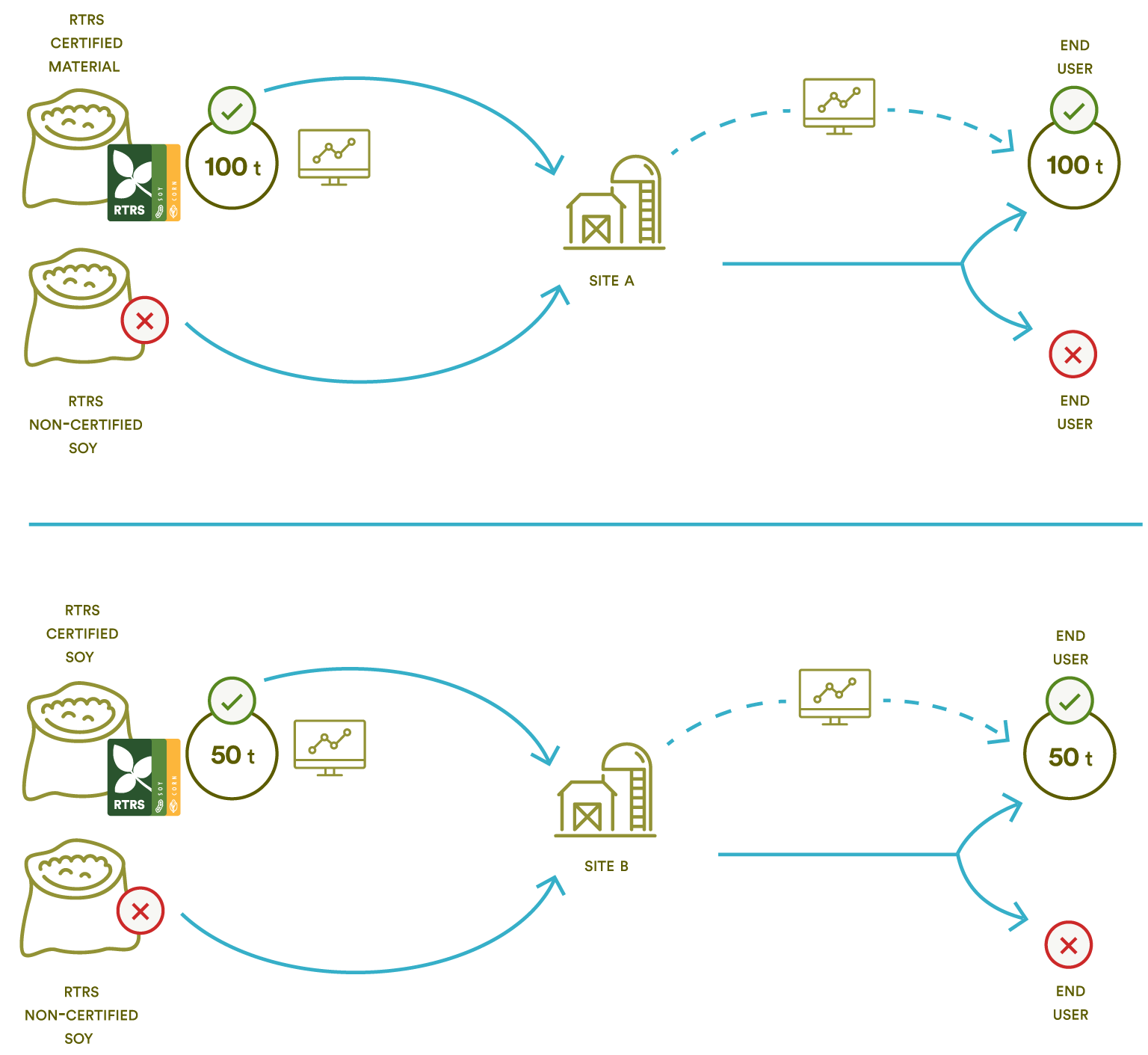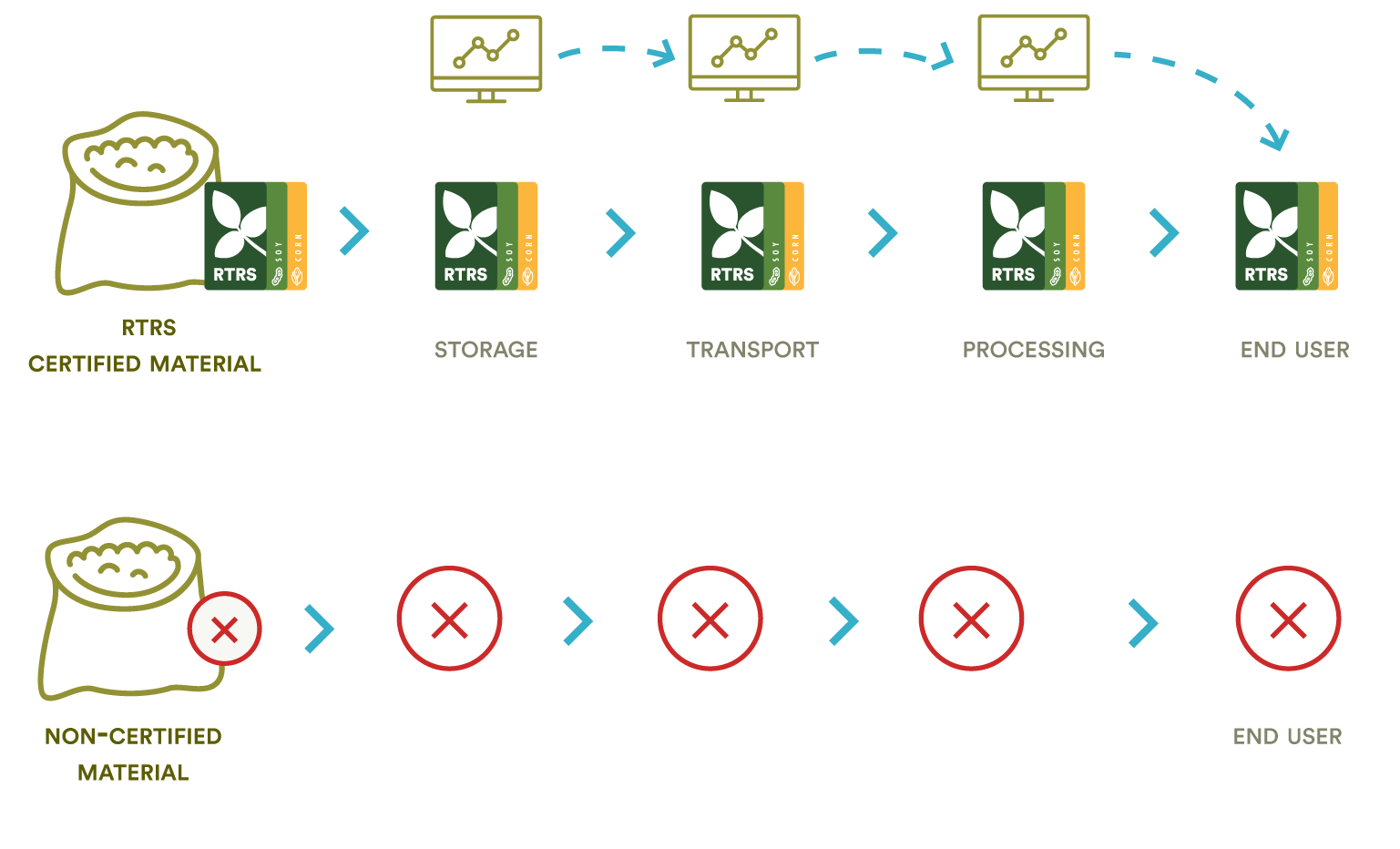How to uptake RTRS-certified material
RTRS certified material can be uptaked as:
Credits
Physical flow
Why acquiring RTRS-certified material?
- Zero deforestation / zero conversion
RTRS Standard for Responsible Soy Production ensures zero deforestation and zero conversion soy production.
- Responsible labor conditions and community relations
RTRS-certified soy meets high social and labor well-being requirements.
- Real and tangible impact
Benefits are seen in the production process, in the environment and in people's quality of life.
- Sustainable sourcing
Production of RTRS-certified soy grows steadily every year.
- Diversification and transparency
There is a wide range of certification standards for the different requirements in each individual company.
- Can be integrated to other crops, oils, grains and seeds
The RTRS Standard for Responsible Corn Production is complementary to the RTRS Standard for Responsible Soy Production and enables expanding the demand for crops produced in a responsible manner.
RTRS Credits
Once certified against the RTRS Standard for Responsible Soy Production, the producer is granted credits equivalent to the volume of certified soy production (1 ton of RTRS-certified soy is equivalent to 1 credit).
The same applies for the new RTRS Standard for Responsible Corn Production, the producer is granted credits equivalent to the volume of certified corn production (1 ton of RTRS-certified corn is equivalent to 1 credit).
Organizations willing to support responsible soy and corn production and supply and/or to balance the impact of soy and corn used in their products can acquire RTRS Credits.
In order to obtain the RTRS Certification for Responsible Soy Production, the producer must comply with 108 mandatory and progressive compliance indicators:
•Legal Compliance and Good Business Practices
•Responsible Labor Conditions
•Responsible Community Relations
•Environmental Responsibility
• Good Agricultural Practices
1 ton of RTRS-certified soy is equivalent to 1 RTRS credit

In accordance with the RTRS Standard for Responsible Corn Production, to obtain certification the producer must only meet 14 additional criteria to the criteria required by the RTRS Standard for Responsible Soy Production.
1 ton of RTRS-certified corn is equivalent to 1 credit

Organizations wishing to buy RTRS Credits can do so in a specific region or country.
This is a tool that makes it easier for the soy market to know from where they are uptaking RTRS Credits, thus allowing greater transparency along the value chain.
The Regional Credits option also applies to corn.
Why Regional credits?
- Contribute to farmers and promote good agricultural practices, conservation of forests and other natural lands in soy-producing countries.
- Connect farmers and adopter organizations, thus contributing, where necessary, to the transition from RTRS Credits to RTRS-certified physical material.
- Foster the growth of communities involved in the certification process in that specific region or country.
- To accompany a possible transition from regional credits to the acquisition of physical soy, on a regional scale.
RTRS Credits global map / RTRS-certified producers


Conozca a los Productores Certificados RTRS
Producers certified against the RTRS Standard for Responsible Soy Production, who have complied with the requirements for Non-GMO soy production at farm-level, are granted credits equivalent to the volume of certified Non-GMO soy production.
This model enables the market to support the responsible production of Non-GMO soy through the purchase of RTRS Non-GMO credits without obtaining any physical Non-GMO soy.
1 ton of non-GMO soy = 1 RTRS non-GMO credit

RTRS-certified physical material
Acquiring RTRS-certified physical material requires the entire supply chain to be certified by the RTRS Chain of Custody (CoC) Standard, to ensure that the soy originates from certified sources.
The CoC Standard describes the requirements for the different traceability systems an organization can implement to keep control of RTRS-certified material inventories, either soybeans or soy byproducts. It can be applied across the entire supply chain and it is mandatory for organizations wishing to receive, process and trade RTRS soy.
RTRS offers three supply chain models to ensure the traceability of RTRS-certified soy.
In Country Material Balance and Site Mass Balance systems, RTRS-certified soy is mixed with non-RTRS-certified soy across the supply chain. In the case of Segregation, RTRS-certified soy is kept physically separate from non-RTRS-certified soy.
When we talk about RTRS certified corn, in the Country Material Balance, site Mass Balance and Segregation, the RTRS certified soy model is replicated.
RTRS-certified operators can aggregate the mass balance accounting systems of several physical sites as a single Mass Balance accounting system at the national level.
The Country Material Balance module is also applicable for RTRS corn.

Site A and Site B use a common accounting system through which the total volumes of RTRS certified soy or derived products entering their unit delivered by either site corresponds to the total volumes of RTRS certified soy or derived products entering both units (100 t + 100t = 200 t). Either site may deliver up to the total volume of RTRS certified soy or derived products available, e.g. if Site A delivers 150 t of RTRS certified soy or derived products, Site B cannot deliver any; if Site A 110 t, Site B can deliver 40 t, etc.
Each transaction leading to the physical transfer of soy or soy-derived products from one economic operator to the next shall be registered on the Online Platform until it reaches the final end user.
Operators maintain separate accounting systems, through which they ensure that the delivered volumes of RTRS-certified soy or derived products correspond to the volumes of RTRS-certified soy or derived products entering their unit.
Soy from one or more RTRS-certified facilities/sites may be mixed with sources of non-certified soy, provided the mixing process is monitored by the company’s management (controlled mixing). The same process applies for corn.

Site A and Site B maintain separate accounting systems, through which they ensure that the delivered volumes of RTRS-certified soy or derived products correspond to the volumes of RTRS certified soy or derived products entering their unit (100 t and 50 t respectively, in the example above).
Each transaction leading to the physical transfer of soy or soy-derived products from one economic operator to the next shall be registered on the Online Platform until it reaches the final end user.
The same process applies for corn.
100% RTRS Soy from one or more RTRS-certified facilities is kept physically separate from other sources of non-RTRS-certified soy.
The same process applies for corn.

Scope for RTRS-certified physical material
RTRS offers certification for non-GMO physical soy applicable to producers and to the entire supply chain since 2011.
The organization shall conduct semi-quantitative real time polymerase chain reaction (PCR) to validate the GMO identity of soy materials they receive and where the organization is growing soy, of the soybeans they supply. Any laboratory conducting semi-quantitative tests for the presence of GMO DNA on their behalf must be competent to do so. Laboratories undertaking PCR tests must be accredited for PCR testing by a recognized Accreditation Body.
The Online Platform keeps record of each transaction resulting in the physical transfer of soy or soy-derived products from one economic agent to the next, until it gets to the end user.

The European Commission´s Renewable Energy Directive (EU-RED) sets out criteria for the import into the European Union of raw material (as soy) for biofuel production. The established criteria address specific requirements on land use change, greenhouse gas (GHG) calculations and traceability, to determine if these raw materials are sustainable.
Annexes include the EU RED Directive requirements, which ensure that producers meet the requirements for supplying soy as raw material for biofuels to European Union member states.

What is the Online Platform?
The platform for traceability and recording of RTRS certified material transactions (the “Online Platform”) is an online global tool that connects stakeholders in the sustainable value chain.
• RTRS Credits is recorded separately from the physical flow.
• In the case of RTRS Physical flow (Country Material Balance, Mass Balance or Segregation), it provides physical traceability records of physical soy and corn
How does the Online Platform work?
Who can become a Online Platform user?
RTRS Members
Every RTRS Member is entitled to an account in the Online Platform and does not have to pay any additional fees.
Learn about the benefits
of RTRS Membership
Non-RTRS Members
Organizations wishing to make transactions and claims about RTRS Credits in Online Platform must pay an annual fee* to be issued a username.
*Annual Fees:
A – Organizations that uptake less than 1,500 MT per year: €100
B – Organizations that uptake more than 1,500 MT per year: €500
If you need more information about the platform, please email us to [email protected]
How to acquire RTRS-certified material
Learn about the uptake options available in the Online Platform.
Credit trading options
In every case, both players must have an account in the Online Platform, and an active user name and password.
The options available in the Online Platform are:
Direct Trade
1. The organization interested in uptaking credits contacts producers and they agree on a volume and price
2. The credit holder makes an offer directly to the adopter organization in the Online Platform.
3. The organization receives an email to confirm the operation and accepts the transaction in the Online Platform.
4. The credits are transferred to the credit adopter’s account.
Invoicing and payment between organisations take place outside the platform.
Blind trade (anonymous)
A. BID (initiated by credit buyers)
1. The credit adopter places a bid for credits (volume and price).
2. An alert is issued to RTRS credit holders
3. The first credit holder to accept the bid gets the transaction
B. OFFER (Initiated by credit holders)
1. The credit holder places an offer for credits (volume and price).
2. An alert is issued to the adopters.
3. The first adopter to accept the transaction gets the credits in his account.
RTRS Secretariat will facilitate contact between the parties to complete the transaction.
RTRS-certified physical material Direct Trade
Organizations offering or acquiring RTRS-certified physical material (Mass Balance or Segregation) can offer it directly, prior agreement on volume and price between the parties.
Organizations uptaking RTRS-certified soy through physical flow must register every transaction in the Online Platform thus assuring physical flow traceability.

Facilities certified under the Chain of Custody Standard must have an account in the Online Platform. The physical owner organization will transfer the volume to the facility where the certified soy will be physically allocated.
RTRS Claims
Make claims to showcase your commitment and support to responsible soy production.
Use the RTRS logo to communicate:
· Purchase of RTRS Credits
· Purchase of RTRS physical material
· RTRS Membership
Organizations wishing to continue making claims about their support of responsible soy production must make the claim annually in the Online Platform.
Before making claims, please read the document
For credit buyers:

For adopters of RTRS certified physical material:

Find out your soy and corn footprint
Our RTRS Soy & Corn Footprint Calculator is a transparent and public tool that allows players in the soy & corn sector, organizations and consumers in general to calculate how much soy and corn is embedded in certain soy (e.g., oil, meal, lecithin) and corn products (e.g., oil, corn flour, gluten meal) animal feed and food products.








